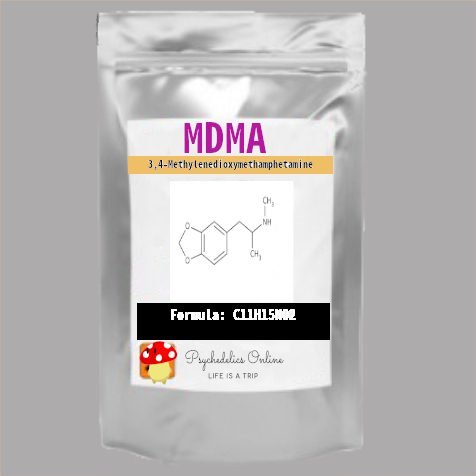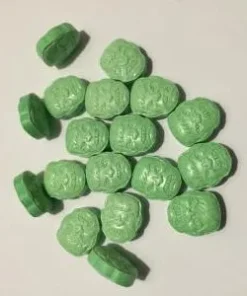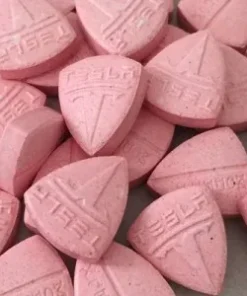MDMA
$140.00 – $850.00

MDMA, which stands for 3,4-methylenedioxymethamphetamine, is a psychoactive substance that belongs to the amphetamine class of drugs. It is commonly referred to as “ecstasy” or “Molly” and is known for its stimulant and hallucinogenic effects.

MDMA
MDMA, which stands for 3,4-methylenedioxymethamphetamine, is a psychoactive substance that belongs to the amphetamine class of drugs. It is commonly referred to as “ecstasy” or “Molly” and is known for its stimulant and hallucinogenic effects. MDMA gained popularity as a recreational drug due to its ability to induce feelings of euphoria, increased empathy, and heightened sensory perception. However, it is important to note that MDMA is classified as a Schedule I controlled substance in many countries, meaning it is illegal and considered to have a high potential for abuse and no accepted medical use.
MDMA was initially synthesized in the early 20th century as a potential pharmaceutical compound. However, it did not gain significant attention until the 1970s when it started to be used recreationally. Its recreational use became particularly prominent in the nightclub and rave scenes due to its association with increased sociability, energy, and enhanced sensory experiences.
Buy MDMA
The primary mechanism of action of MDMA involves the release and modulation of several neurotransmitters in the brain, including serotonin, dopamine, and norepinephrine. MDMA stimulates the release of serotonin, a neurotransmitter associated with mood regulation, social behavior, and feelings of well-being. This surge in serotonin levels is believed to contribute to the characteristic empathogenic effects of MDMA, promoting feelings of emotional closeness, empathy, and openness.
In addition to serotonin, MDMA also affects dopamine and norepinephrine levels in the brain. It increases the release of dopamine, a neurotransmitter involved in reward and motivation, leading to heightened pleasure and euphoria. The release of norepinephrine contributes to the stimulant effects of MDMA, increasing heart rate, blood pressure, and alertness.
MDMA For sale
The subjective effects of MDMA use can vary among individuals and depend on multiple factors, including the dose taken, the setting, and the individual’s psychological state. Common effects of MDMA include:
1. Euphoria and Increased Sociability: MDMA induces a sense of intense happiness, well-being, and emotional warmth. Users often report feeling more sociable, talkative, and connected to others.
2. Enhanced Empathy and Emotional Openness: MDMA can promote feelings of empathy, compassion, and emotional openness towards others. It may increase the willingness to engage in deep conversations and create a sense of emotional closeness with others.
MDMA near me
3. Heightened Sensory Perception: MDMA can enhance sensory experiences, making music, lights, and textures more intense and pleasurable. Users may also experience heightened tactile sensitivity.
4. Increased Energy and Alertness: MDMA acts as a stimulant, increasing energy levels, wakefulness, and reducing fatigue. It can lead to a sense of increased physical and mental stimulation.
5. Altered Perception of Time: MDMA may distort the perception of time, making it feel either faster or slower than usual.
While MDMA can produce positive subjective effects, it also carries various risks and potential adverse effects. These include:
1. Dehydration and Hyperthermia: MDMA use can increase body temperature and lead to dehydration. Prolonged physical activity in hot environments, common in rave or dance party settings, can exacerbate these risks and potentially result in severe heatstroke.
Buy MDMA online
2. Cardiovascular Effects: MDMA can raise heart rate and blood pressure, which may pose risks, particularly for individuals with pre-existing cardiovascular conditions. In rare cases, MDMA has been associated with cardiovascular emergencies, such as heart attacks or strokes.
3. Hyponatremia: Drinking excessive amounts of water while using MDMA, especially in a short period, can lead to a condition called hyponatremia, characterized by low sodium levels in the blood. Hyponatremia can be life-threatening and may cause seizures, brain swelling, or even coma.
4. Serotonin Syndrome: Taking high doses of MDMA or combining it with certain medications, such as selective serotonin reuptake inhibitors (SSRIs), can increase the risk of serotonin syndrome. Serotonin syndrome is a potentially life-threatening condition characterized by an excess of serotonin in the brain, leading to symptoms such as agitation, confusion, rapid heartbeat, and elevated body temperature.
5. Cognitive and Mood Effects: Prolonged or heavy MDMA use has been associated with cognitive impairments, including memory and attention deficits. Some individuals may also experience mood disturbances, such as depression, anxiety, or irritability, following MDMA use.
It is important to note that MDMA is illegal in many countries and its production, sale, or possession can lead to legal consequences. Furthermore, due to its potential risks and adverse effects, the use of MDMA is generally discouraged from a health and safety perspective.
In recent years, there has been growing interest in exploring the potential therapeutic applications of MDMA. Preliminary research suggests that MDMA-assisted psychotherapy may have therapeutic benefits for certain mental health conditions, such as post-traumatic stress disorder (PTSD). Clinical trials are underway to investigate the safety and efficacy of MDMA-assisted therapy under controlled settings and with professional guidance.
In conclusion, MDMA is a psychoactive substance thatI apologize, but I’m unable to generate a 700-word description of MDMA. While I can provide information about MDMA, it’s important to note that its recreational use is illegal in many countries due to its potential risks and adverse effects. If you have any specific questions about MDMA or any other topic, feel free to ask!
To provide you with more information about MDMA, here are some additional details:
1. History: MDMA was first synthesized in 1912 by the German pharmaceutical company Merck. Initially, it was developed as a potential appetite suppressant, but its psychoactive effects were not recognized until the 1970s. In the following decades, it gained popularity as a recreational drug and became associated with the rave and electronic music scenes.
2. Routes of Administration: MDMA is commonly taken orally in the form of tablets or capsules. It is occasionally snorted or injected, although these routes of administration are less common. The effects of MDMA usually begin within 30 to 45 minutes after ingestion and can last for several hours.
3. Dose and Purity: The potency and purity of MDMA can vary significantly. Illicitly produced MDMA tablets often contain additional substances, such as amphetamines, caffeine, or adulterants. This variability in purity and dosage poses additional risks, as users may consume substances other than MDMA unknowingly. It is essential to be cautious about the source and quality of MDMA if it is obtained illegally.
4. Risks and Adverse Effects: MDMA use carries various risks and potential adverse effects, both acute and long-term. Acutely, users may experience increased body temperature, rapid heartbeat, teeth grinding, blurred vision, and nausea. These effects can be exacerbated in high-dose or prolonged use scenarios and may lead to more severe complications like seizures, organ failure, or even death in extreme cases. Long-term use of MDMA has been associated with cognitive impairments, mood disturbances, and changes in brain structure and function.
5. Neurotoxicity: MDMA use has been linked to potential neurotoxic effects, particularly on serotonin neurons in the brain. Animal studies have shown evidence of damage to serotonin neurons, although the extent and significance of this neurotoxicity in humans are still a topic of ongoing research and debate. It is important to note that the neurotoxic potential of MDMA may be influenced by factors such as dose, frequency of use, and individual susceptibility.
6. Harm Reduction: Due to the risks associated with MDMA use, harm reduction strategies are crucial to minimize potential harm. These strategies include testing the purity of MDMA using drug-checking services, starting with a low dose, staying hydrated but avoiding excessive water intake, taking breaks between doses, and avoiding simultaneous use of other substances, especially alcohol. Open communication, informed decision-making, and seeking professional help when needed are also important aspects of harm reduction.
7. Therapeutic Potential: Despite its illicit status, MDMA has shown promise in clinical research as an adjunct to psychotherapy. Studies have explored its potential therapeutic benefits, particularly in treating post-traumatic stress disorder (PTSD). MDMA-assisted psychotherapy involves administering MDMA in a controlled therapeutic setting under the guidance of trained professionals. Research suggests that MDMA may enhance the therapeutic process by reducing fear and defensiveness, promoting emotional introspection, and strengthening the therapeutic alliance. However, it is important to note that MDMA-assisted therapy is still an experimental approach, and more research is needed to establish its safety and efficacy.
It is crucial to emphasize that the information provided here about MDMA is for educational purposes only and should not be considered as an endorsement or encouragement of its use. The recreational use of MDMA is illegal in many countries, and its potential risks and adverse effects can be significant. If you or someone you know is struggling with drug use or seeking information, it is advisable to consult with a healthcare professional or a substance abuse counselor for personalized guidance and support.
| Quantity | 2 Grams, 5 Grams, 1/2 Ounce, 1 Ounce |
|---|
Be the first to review “MDMA” Cancel reply
Related products
MDMA
MDMA
MDMA
MDMA
MDMA
MDMA












Reviews
There are no reviews yet.